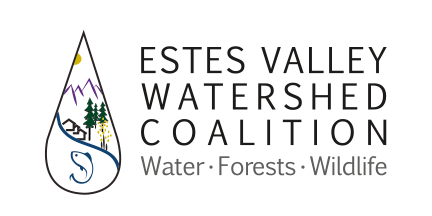EVWC helps Hurni Tree Farm with Fuels Reduction Project
by Jenny Forrester
Michelle and George Hurni own forty-five acres above Mary's Lake. In 2022, The Hurnis received a grant through the Mary’s Lake Forest Health Project, a project initiated and designed by the Estes Valley Water Coalition with the support of the Colorado State Forest Service and Northern Water. The Project provides support to landowners to address the danger of wildfire in this high-risk area and to help protect the Mary’s Lake water supply.
Prior to the Hurni purchase, the property was in Colorado State University’s Agriculture Program with a 10-year plan to expand the diversity of species on the property as species diversity is a crucial component of forest health and therefore, water supply purity. Five years ago, the Hurnis received their wildfire mitigation plan to improve defensibility of the property, its structures, and the neighboring community. The CSU program requires that product be sold so the Hurnis sell Christmas trees and wreaths and sometimes, firewood, which also ensures the property’s forestry tax status. Each year, CSU conducts a survey to ensure the mitigation process is on target so a forester walks the property and makes a map. This year, Forester Mike Hughes, carrying an iPad, created a digital map for the Hurni’s which they shared with EVWC.
All this means a lot of work for the Hurnis.
Ms. Hurni said, “When lodgepole pine blows down, the clean up is part of the mitigation operations. Then there’s thinning all the areas so that none of the tree branches touch the others. Overlapping trees spread disease more easily, and they catch each other on fire.”
The Hurni property is treed with aspen and ponderosa and a preponderance of lodgepole and its accompanying mistletoe. Removing infected lodgepole pine trees is the best way to control dwarf mistletoe in mature lodgepole pine.
The Colorado State Forest Service does some mitigation, but mostly the Hurnis rely on hired hands like Noah Simpson who is utterly invaluable because of his incredible work ethic and his wildland firefighting skills. The Hurni’s also rely on volunteers from the Worldwide Opportunities on Organic Farms (WWOOF) program in the USA. The WWOOF movement works to link visitors (WWOOFers) with organic farmers, to promote a cultural and educational exchange, and to build a global community conscious of ecological farming and sustainability practices. Using the grant funds secured by EVWC, the Hurnis were able to pay their WWOOFer’s, Amanda Miller and Robert Parker.
Michelle Hurni expressed her gratitude to EVWC. She said, “We had just bought our property and they reached out, and then we got the grant last year. They do such a good job helping property owners mitigate their property for the safety of the area.”
The EVWC grant funds help owners cover the financial costs of forest mitigation. So far, the grant has covered sixteen acres on the Hurni property.
Hurni’s wish for the property is that it will be 100% mitigated next year, and her dream for it (when asked) is beautiful, “My dream is to grow meadows.” This dream is in line with the historical topography of the area–stands of fire-tolerant aspen and ponderosa and wildlife-filled meadows.
